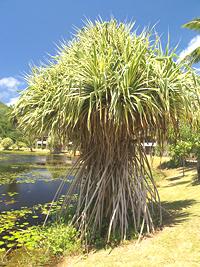
SAFARI
Users
Pandan
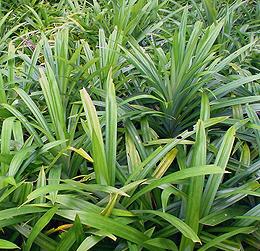 [Daun Pandan (Indonesia); Pandan wangi (Malay); Bai Toey (Thailand);
Dua thom, La dua (Viet); Pandanus amaryllifolius]
[Daun Pandan (Indonesia); Pandan wangi (Malay); Bai Toey (Thailand);
Dua thom, La dua (Viet); Pandanus amaryllifolius]
Strangely, this is the only pandanus with fragrant leaves, and they lack the dangerous sawtooth edges typical of pandanus. It also does not exist in the wild because it is sterile. Male flowers are extremely rare and female flowers have never been recorded by botanical science. It is, however, widespread through Southeast Asia by cultivation, propagated by cuttings. It is a small pandanus growing to a maximum of about 6 feet.
Pandan is predominantly used to flavor rice and sweet deserts. For sweets pandan extract is often used rather than the leaves, and it's often dyed a brilliant (hideous) green, the kind of colors Asians seem to like in their desserts. Pandan leaves are also used to wrap chicken before frying, lending it a light aromatic flavor. Photo by Dekoelie distributed under license Creative Commons Attribution 1.0 Generic.
Buying:
Pandan leaves are widely available in the forzen food cases of Asian markets. They are usually full strap leaves about 19 inches long, but may also appear folded or in other forms.Hala
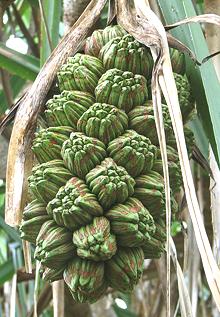 [Hala tree (Hawaii); Pandanus tectorius]
[Hala tree (Hawaii); Pandanus tectorius]
The exact origin of this tree is unknown as it was taken by Polynesians as far south as southeastern Australia and as far east as Hawaii. It is a medium size tree growing to about 45 feet and bears fruit up to nearly 8 inches diameter and 12 inches long.
The fruit of this tree, raw or cooked, is a very important food source
through most of Micronesia where most food plants won't grow. It is not
favored in Hawaii but has been eaten there in times of scarcity. The leaves,
stripped of their toothy edges, were used in Hawaii to make grass skirts and
woven into mats. Less carefully de-toothed leaves were used to thatch
roofs.
Photo by Amos T Fairchild distributed under license
Creative Commons
Attribution-Share Alike 2.5 Generic.
Kiekie
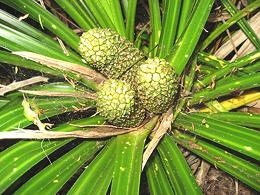 [Freycinetia banksii]
[Freycinetia banksii]
Native to New Zealand, this pandanus is a tree climbing vine rather
than a tree. In other characteristics, including aerial roots, it resembles
the tree forms. If they can't find convenient trees to climb they make a
tangled mass on the ground. The fruit is sweet and the flower bracts succulent, and both
were appreciated by the native Maori in past times. Of course they also used
the leaves for craft materials just as other populations used their pandanus.
Photo by Kahuroa contributed to the public domain.
Red Fruit
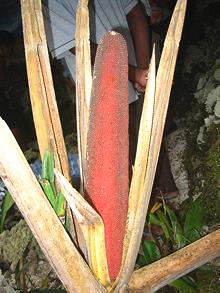 [Kuansu (Papua); Buah merah (Indonesia); Pandanus conoideus]
[Kuansu (Papua); Buah merah (Indonesia); Pandanus conoideus]
Endemic to Papua (formerly Dutch New Guinea) this pandanus produces
elongated red fruits which may grow longer than 3 feet and 7 inches
diameter. The fruits are edible and are typically split, wrapped in
leaves and baked in an earth oven. Some are promoting it as having
anti-AIDS properties, but there is no organized evidence for this.
Photo by
Paul distributed
under license
Creative Commons Attribution 2.0 Generic.
Kewra
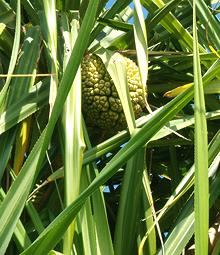 [Kewra, Kewda (Hindi); Ketaki, Kewda (Marathi); Keora (Bengali);
Kiora (Urdu); Pandanus fascicularis]
[Kewra, Kewda (Hindi); Ketaki, Kewda (Marathi); Keora (Bengali);
Kiora (Urdu); Pandanus fascicularis]
This pandanus is found from southern India to Taiwan and the Ryukyu
Islands. Its aromatic male flowers are processed into flower essences
used to flavor food, mainly in northern India. they are also used to make
perfumes, aromatic oils and medicinal distillates. Kewra water is
interchangeable with other flower essences such as rose and orange water.
The flowers are reputed to attract snakes.
Photo by Razib Mustafiz distributed under license Creative
Commons
Attribution-ShareAlike v3.0 Unported.
